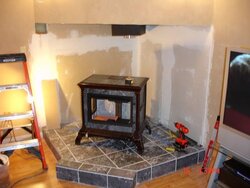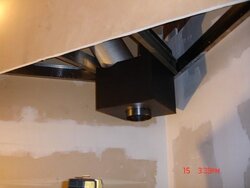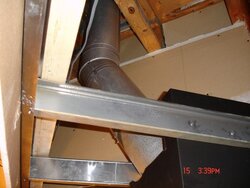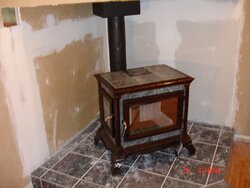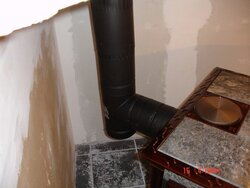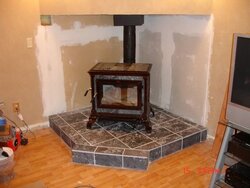So it begins
- Thread starter DonCT
- Start date
-
Active since 1995, Hearth.com is THE place on the internet for free information and advice about wood stoves, pellet stoves and other energy saving equipment.
We strive to provide opinions, articles, discussions and history related to Hearth Products and in a more general sense, energy issues.
We promote the EFFICIENT, RESPONSIBLE, CLEAN and SAFE use of all fuels, whether renewable or fossil.
You are using an out of date browser. It may not display this or other websites correctly.
You should upgrade or use an alternative browser.
You should upgrade or use an alternative browser.
- Status
- Not open for further replies.
MountainStoveGuy
Minister of Fire
look great. nice choice of stove. that install looks very familer. GREAT JOB. I think i want to put a T on mine. I like the cookplate.
tradergordo
Minister of Fire
Just curious, but did you guys determine the "R value" for your hearths? I'm still a bit confused on this. According to my manual (and many others I've found on the web) your hearth has to have an R value of at least 1.19. I've found several charts on the web and even in some install manuals listing various materials and their R values. Durock has an r-value of .52 per inch, which, if I'm not mistaken, means you need a minimum of 2.29 inches to meet code and pass inspection in most areas. That seems to be the reason other people are using alternate materials like micore 300.
Thoughts?
I just bought my wood stove and I'm ready to build the hearth - but still gathering information.
Thoughts?
I just bought my wood stove and I'm ready to build the hearth - but still gathering information.
E
elkimmeg
Guest
Your principle is right but math needs work .5 2 x 2= 1.04 1.5 " of dure rock excceeds 1.19 where do you get needing 2"?
the tile surface may meet your requirements with one inch dura rock good luck there are other materials to use as well
the tile surface may meet your requirements with one inch dura rock good luck there are other materials to use as well
Also, I went by what my stove manual stated for R value. If you follow that, you won't have any troubles with inspection. Technically, I could have built the pad out of 2x4's instead of metal stud, but I did that as a fudge factor. The actual R value of the pad I built is closer to 3 or so...... didn't really do the math. I just know I met the minimum as listed in the manual.
If you can get Micore, that will allow you to make the pad much thinner. Add to that durock and tile, you shouldn't have a problem.
If you can get Micore, that will allow you to make the pad much thinner. Add to that durock and tile, you shouldn't have a problem.
tradergordo
Minister of Fire
elkimmeg said:Your principle is right but math needs work .5 2 x 2= 1.04 1.5 " of dure rock excceeds 1.19 where do you get needing 2"?
the tile surface may meet your requirements with one inch dura rock good luck there are other materials to use as well
OK - I feel retarded, but can you elaborate because I don't follow. .52 x 2 = 1.04. Doesn't that mean 2" of durock gets you an r-value of 1.04? But the minimum requirement is 1.19.
1.19 divided by .52 = 2.29
What am I missing?
Of course this is ONLY considering the durock layer. The tile has some r value, although I also read you should not even count the tile towards your total because you never know for sure what its value actually is unless you can find some specific rated name brand, and then you have the issue of the grout.
E
elkimmeg
Guest
Dura rock comes in 1/2" thick sheets not trying to discourage you. I believe it is r.54 per the 1/2 " I think you assumed they were 1" thick but I will check after golfing, I could be wrong. I may have made the false assumption .54 = 1/2" thickness
Wonder board is another cemnet board which may have slightly different characteristics or R value There is also two grades of Micore, which is commonly used for ceiling tiles, some used in fire rated assemblies. Which might be used and purchased at Home cheapo. Post this question up on the main forum not in the picture section you will get quite a few more replies Hearth room
Wonder board is another cemnet board which may have slightly different characteristics or R value There is also two grades of Micore, which is commonly used for ceiling tiles, some used in fire rated assemblies. Which might be used and purchased at Home cheapo. Post this question up on the main forum not in the picture section you will get quite a few more replies Hearth room
tradergordo
Minister of Fire
OK - I posted my question in the main forum. I originally posted it here because Don used two sheets of durock (one inch total thickness) so I figured he would be a good source on describing the total R value of his hearth.
According to:
https://www.hearth.com/articles/64_0_1_0_M1.html
One inch of durock/wonderboard only has an R value of .52 (yes, that is per inch). I know the air gap in don's hearth would also increase the hearth's total R value but I have no idea how much, and as I said before, based on what I've read the tiles are not included in the total at all. Did the inspector require or provide an actual R value calculation? Did you stove install manual specify a minimum R value for your hearth?
I guess the key is the R value of the air space. I assume that is what brought Don's total up to an acceptable level (he would NOT have been able to use wood studs and still meet code with just one inch of durock - I'm pretty certain of that, as the air space would then not be counted towards the total)
According to:
https://www.hearth.com/articles/64_0_1_0_M1.html
One inch of durock/wonderboard only has an R value of .52 (yes, that is per inch). I know the air gap in don's hearth would also increase the hearth's total R value but I have no idea how much, and as I said before, based on what I've read the tiles are not included in the total at all. Did the inspector require or provide an actual R value calculation? Did you stove install manual specify a minimum R value for your hearth?
I guess the key is the R value of the air space. I assume that is what brought Don's total up to an acceptable level (he would NOT have been able to use wood studs and still meet code with just one inch of durock - I'm pretty certain of that, as the air space would then not be counted towards the total)
hearthtools
Moderator Emeritus
Like the photos
Steel Studs are great. we used them for everything now.
we use the track for our framing of our supports boxes on New contruction and Remodels.
can I use them in my shop for examples.
Do you have any more you can email to me?
[email protected]
Steel Studs are great. we used them for everything now.
we use the track for our framing of our supports boxes on New contruction and Remodels.
can I use them in my shop for examples.
Do you have any more you can email to me?
[email protected]
Highbeam
Minister of Fire
Sorry to dig up old threads but.... I see you used the deitrich non-structural studs for your steel stud base. So did I. Lot's of screws and really close spacing. These studs just aren't the same as wood in terms of apparent strength, they seemed like they would fold up to me with their open C channel shape. When using the studs as a platform there is no manufacturer guidance on strength, the manufacturer makes these for walls and such.
How are they holding up? Did they flex at all when the stove was installed? Do they creak or moan? Any cracked tiles at the feet of your stove?
I have built my pad similarly with steel studs and then screwed 3+ sheets (two layers) of durock at 96 lbs per sheet, thinset between, and tile on top. Everything is very solid feeling and the studs are supporting 350-400 lbs right now. I am a little worried about adding 500 lbs of stove plus two burley guys lifting said stove. Easily putting 1000 lbs of weight onto my platform. The floor below is very adequate but I have fears of the platform collapsing either upon installation or when burning some day.
Am I just getting anxious or has anyone ever seen a steel stud platform squished? Install scheduled for Aug 14th.
How are they holding up? Did they flex at all when the stove was installed? Do they creak or moan? Any cracked tiles at the feet of your stove?
I have built my pad similarly with steel studs and then screwed 3+ sheets (two layers) of durock at 96 lbs per sheet, thinset between, and tile on top. Everything is very solid feeling and the studs are supporting 350-400 lbs right now. I am a little worried about adding 500 lbs of stove plus two burley guys lifting said stove. Easily putting 1000 lbs of weight onto my platform. The floor below is very adequate but I have fears of the platform collapsing either upon installation or when burning some day.
Am I just getting anxious or has anyone ever seen a steel stud platform squished? Install scheduled for Aug 14th.
Once the studs are fastened and covered with durock, it's solid as a rock. They're not going to be slamming stuff around, so you should be ok.
When my Heritage was installed, there were 3 of us (I was the lightest at 230) and the stove (450). No issues.
As long as the studs are installed with care and placed accordingly (I think I used 16" OC), I think I could support quite a bit of weight.
When my Heritage was installed, there were 3 of us (I was the lightest at 230) and the stove (450). No issues.
As long as the studs are installed with care and placed accordingly (I think I used 16" OC), I think I could support quite a bit of weight.
Highbeam
Minister of Fire
Thanks Don. On average I used 12" spacing, between studs that were on average 16" long so pretty small spans. The average spacing was due to a little cheating in the middle to get a stud under each leg of the stove. One layer of durock with screws was a little flexy, obviously no good for tile. Wet mortar then another screwed layer of durock and things were a bit better but I could hear creaks wwhen walking on it until that mortar had time to set up and then the assembly got real solid and quiet.
How did you lift the stove and then move and set it? There must have been some sort of trick to avoid dragging it across the tile and also to lift it the 4 inches.
How did you lift the stove and then move and set it? There must have been some sort of trick to avoid dragging it across the tile and also to lift it the 4 inches.
Simply 3 burly dudes getting hernias

Seriously, that sucker is a massive chunk of stove, so be VERY careful lifting and moving it! I was worried when we placed it, but that quickly faded once it was in. As I said, you're not gonna be slamming 1000 lbs down on that thing. Sounds like you've got your hearth set up to take the pressure from the feet and distribute it.
But what I wanna know is..... WHERE'S THE PICTURES????????


Seriously, that sucker is a massive chunk of stove, so be VERY careful lifting and moving it! I was worried when we placed it, but that quickly faded once it was in. As I said, you're not gonna be slamming 1000 lbs down on that thing. Sounds like you've got your hearth set up to take the pressure from the feet and distribute it.
But what I wanna know is..... WHERE'S THE PICTURES????????

Highbeam
Minister of Fire
I've taken them, for you folks and for the inspector. I just haven't gotten them all together for a thread like yours. I promise, there will be pictures. You'll even get to see my rather interesting outside air ductwork that uses the steel stud cavities for routing.
wowchad
Member
- Status
- Not open for further replies.
Similar threads
- Replies
- 6
- Views
- 821
- Replies
- 8
- Views
- 1K
- Replies
- 7
- Views
- 347
- Replies
- 30
- Views
- 3K


